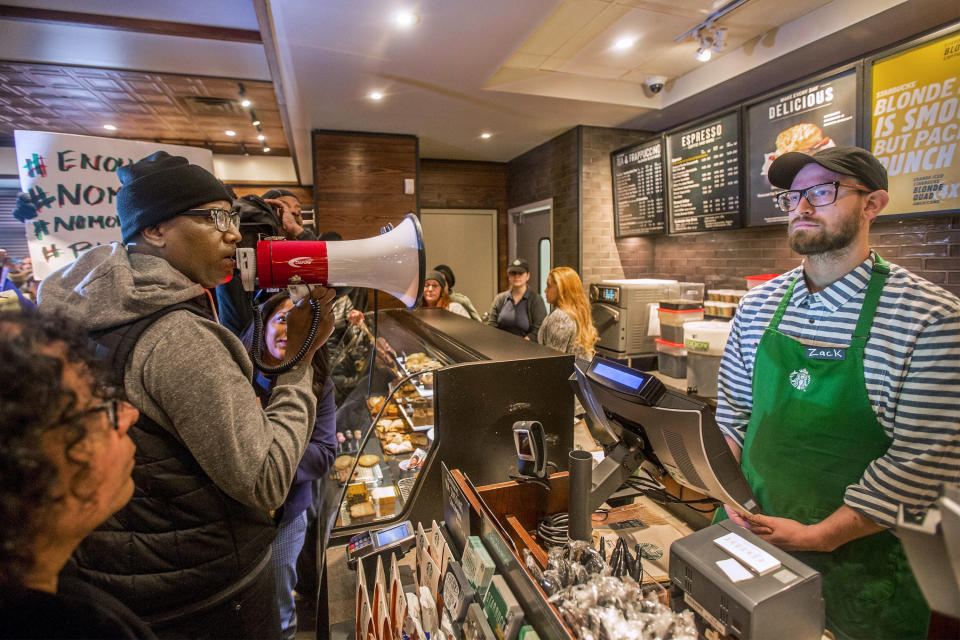Starbucks closure, jobs report — What you need to know for the week ahead
May is almost over and the stock market has done basically nothing for the year.
This past week was defined by a flurry of political headlines impacting markets, with Thursday’s news that President Donald Trump had canceled an expected meeting with North Korean leadership set for next month the biggest news.
Oil prices were also impacted by political headlines with Friday’s 3% drop in the price of crude oil attributed to a Reuters report which said OPEC production could be increased after last month’s complain by Trump that prices had risen “artificially” because of decreased production.
But amid what still feels like a volatile year for markets, recent weeks have seen the U.S. indexes essentially run in place. This lack of direction will have traders bracing for a violent move up or down in stocks as we head into the summer months.
In the week ahead, the biggest economic event will be the May jobs report. On Friday morning, the Bureau of Labor Statistics will release its report on employment in May, with economists expecting the economy added 190,000 jobs during the month with the unemployment rate expected to remain steady at 3.9%.

Markets will also be watching wage gains, which have increased over the last 18 months but not accelerated to the extent that some economists would’ve expected given the low level of unemployment. Over the prior year, average hourly earnings are expected to rise 2.6% in May.
On the corporate side, notable earnings in the week ahead should come from HP Inc (HPQ), Salesforce.com (CRM), Box (BOX), Dick’s Sports Goods (DKS), Costco (COST), lululemon (LULU), Ulta Beauty (ULTA), and Abercrombie & Fitch (ANF).
The week’s biggest corporate news, however, is likely to be Tuesday’s closure of Starbucks (SBUX) stores across the country for racial bias training. This move comes after two black men were removed from a Philadelphia Starbucks in April, sparking outrage and leading the company to change its policies to allow people to stay in their stores without making any purchases.
Markets will also be closed on Monday in the U.S. in observation of the Memorial Day holiday.

Economic calendar
Monday: Markets closed for Memorial Day.
Tuesday: Case-Shiller home price index, March (+0.85% expected; +0.83% previously); The Conference Board consumer confidence, May (128 expected; 128.7 previously); Dallas Fed manufacturing index, May (24.5 expected; 21.8 previously)
Wednesday: ADP private payroll growth, May (+190,000 expected; +204,000 previously); First quarter GDP growth, second estimate (+2.3% expected; +2.3% previously); First quarter personal consumption growth, second estimate (+1.3% expected; +1.1% previously); Federal Reserve Beige Book
Thursday: Initial jobless claims (230,000 expected 234,000 previously); Personal income, April (+0.3% expected; +0.3% previously); Personal spending, April (+0.4% expected; +0.4% previously); “Core” PCE, year-on-year, April (+1.8% expected; +1.9% previously); Chicago PMI, May (58 expected; 57.6 previously); Pending home sales, April (+0.5% expected; +0.4% previously)
Friday: Nonfarm payroll growth, May (+190,000 expected; +164,000 previously); Unemployment rate, May (3.9% expected; 3.9% previously); Average hourly earnings, month-on-month, May (+0.2% expected; +0.1% previously); Average hourly earnings, year-on-year, May (+2.6% expected; +2.6% previously); Markit manufacturing PMI, May (56.7 expected; 56.6 previously); ISM manufacturing PMI, May (58.1 expected; 57.3 previously); Construction spending, April (+0.8% expected; -1.7% previously)
Oil and the U.S. economy
The basic framework for many discussions about oil and the U.S. economy is simple — low oil prices are good because it allows people to spend less on gas and more on other stuff.
This proved only partially true during the oil crash seen in 2014-15.
Now that oil prices have begun rising — with gas prices up over $1 a gallon, on average, across the country since hitting their lows in early 2016 — questions have arisen about whether higher energy costs could hold back an economy benefiting from a huge tax cut passed last year.
Earlier last week, we highlighted work out of UBS which argued that the overall economic benefits of increased investment from oil companies due to rising prices would outweigh any hit to spending power. That is, as long as oil prices stayed below $120 a barrel, which would require a roughly 60% increase from current prices.
In a note to clients out over the weekend, Andrew Hunter at Capital Economics looked at the same issue and reached a similar conclusion.
But this analysis also highlights the new way that we ought to understand oil prices as impacting the U.S. economy more broadly. Namely, that because oil production is a bigger part of the economy overall, higher investment as a result of higher prices offset negative impacts to consumers.

U.S. oil production has ramped up sharply over last 15 years and a flood of supply come onto the market due to improvements in fracking technology sent prices plummeting four years ago.
Unlike major state-run oil companies like those run by members of OPEC, smaller U.S.-based frackers will ramp their oil production up or down quickly. So as more rigs came offline following the collapse in prices, supply normalized, sending prices higher. Higher prices, however, eventually encouraged another increase in investment in the U.S. energy sector.
“Overall, if oil prices were to hold to their recent gains, we would expect mining investment to make a similar 0.2% to 0.3% point contribution to GDP growth in 2018 as a whole,” Hunter writes. “That would go some way towards offsetting the hit to consumers’ purchasing power from higher gasoline prices.”
Hunter adds that this also explains both why the collapse in 2014-15 prices didn’t boost the economy as some had expected — the loss in mining investment more than offset gains. As prices recover, then, the GDP benefits from more investment offset the losses in disposable income as a result of higher gas prices.
Oil prices, then, are no longer a one-way economic street for the U.S. economy where low prices are good for consumers and good for the economy-at-large.
So while President Trump has complained about “artificially” high oil prices and OPEC has taken notice of this, the overall role oil plays in the U.S. economy has dramatically changed in recent years. And it’s time to talk about the impacts from oil prices changes accordingly.
—
Myles Udland is a writer at Yahoo Finance. Follow him on Twitter @MylesUdland

 Yahoo Finance
Yahoo Finance 
